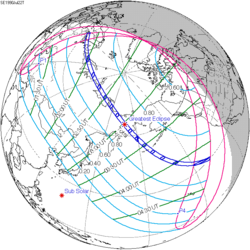| Annular eclipse | |
 Annular from Madrid, Spain | |
| Gamma | 0.3306 |
|---|---|
| Magnitude | 0.9576 |
| Maximum eclipse | |
| Duration | 272 s (4 min 32 s) |
| Coordinates | 12°54′N28°42′E / 12.9°N 28.7°E |
| Max. width of band | 162 km (101 mi) |
| Times (UTC) | |
| (P1) Partial begin | 3:53:56 |
| (U1) Total begin | 18:40:59 |
| Greatest eclipse | 10:32:47 |
| (U4) Total end | 1:22:35 |
| (P4) Partial end | 24:27:52 |
| References | |
| Saros | 134 (43 of 71) |
| Catalog # (SE5000) | 9520 |
An annular solar eclipse occurred at the Moon's descending node of orbit on Monday, October 3, 2005, [1] [2] [3] with a magnitude of 0.958. A solar eclipse occurs when the Moon passes between Earth and the Sun, thereby totally or partly obscuring the image of the Sun for a viewer on Earth. An annular solar eclipse occurs when the Moon's apparent diameter is smaller than the Sun's, blocking most of the Sun's light and causing the Sun to look like an annulus (ring). An annular eclipse appears as a partial eclipse over a region of the Earth thousands of kilometres wide. Occurring about 4.75 days after apogee (on September 28, 2005, at 16:20 UTC), the Moon's apparent diameter was smaller. [4]
Contents
- Visibility
- Eclipse timing
- Places experiencing annular eclipse
- Places experiencing partial eclipse
- Gallery
- Eclipse details
- Eclipse season
- Related eclipses
- Eclipses in 2005
- Metonic
- Tzolkinex
- Half-Saros
- Tritos
- Solar Saros 134
- Inex
- Triad
- Solar eclipses of 2004–2007
- Saros 134
- Metonic series
- Tritos series
- Inex series
- Notes
- References
Annularity was visible from a narrow corridor through Portugal, Spain, Algeria, Tunisia, Libya, Chad, Sudan, Ethiopia, Kenya and Somalia. A partial eclipse was seen from the much broader path of the Moon's penumbra, including most of Europe, Africa, the Middle East, and South Asia. Another solar eclipse in Africa occurred just 6 months later.


















































































































